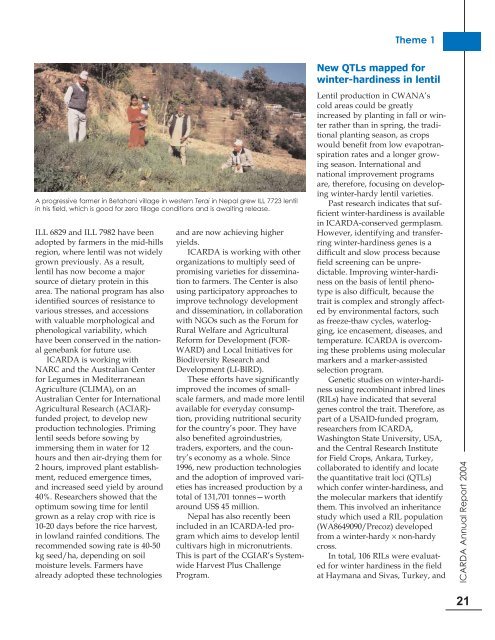ICARDA annual report 2004
ICARDA annual report 2004
ICARDA annual report 2004
You also want an ePaper? Increase the reach of your titles
YUMPU automatically turns print PDFs into web optimized ePapers that Google loves.
A progressive farmer in Betahani village in western Terai in Nepal grew ILL 7723 lentil<br />
in his field, which is good for zero tillage conditions and is awaiting release.<br />
ILL 6829 and ILL 7982 have been<br />
adopted by farmers in the mid-hills<br />
region, where lentil was not widely<br />
grown previously. As a result,<br />
lentil has now become a major<br />
source of dietary protein in this<br />
area. The national program has also<br />
identified sources of resistance to<br />
various stresses, and accessions<br />
with valuable morphological and<br />
phenological variability, which<br />
have been conserved in the national<br />
genebank for future use.<br />
<strong>ICARDA</strong> is working with<br />
NARC and the Australian Center<br />
for Legumes in Mediterranean<br />
Agriculture (CLIMA), on an<br />
Australian Center for International<br />
Agricultural Research (ACIAR)funded<br />
project, to develop new<br />
production technologies. Priming<br />
lentil seeds before sowing by<br />
immersing them in water for 12<br />
hours and then air-drying them for<br />
2 hours, improved plant establishment,<br />
reduced emergence times,<br />
and increased seed yield by around<br />
40%. Researchers showed that the<br />
optimum sowing time for lentil<br />
grown as a relay crop with rice is<br />
10-20 days before the rice harvest,<br />
in lowland rainfed conditions. The<br />
recommended sowing rate is 40-50<br />
kg seed/ha, depending on soil<br />
moisture levels. Farmers have<br />
already adopted these technologies<br />
and are now achieving higher<br />
yields.<br />
<strong>ICARDA</strong> is working with other<br />
organizations to multiply seed of<br />
promising varieties for dissemination<br />
to farmers. The Center is also<br />
using participatory approaches to<br />
improve technology development<br />
and dissemination, in collaboration<br />
with NGOs such as the Forum for<br />
Rural Welfare and Agricultural<br />
Reform for Development (FOR-<br />
WARD) and Local Initiatives for<br />
Biodiversity Research and<br />
Development (LI-BIRD).<br />
These efforts have significantly<br />
improved the incomes of smallscale<br />
farmers, and made more lentil<br />
available for everyday consumption,<br />
providing nutritional security<br />
for the country’s poor. They have<br />
also benefited agroindustries,<br />
traders, exporters, and the country’s<br />
economy as a whole. Since<br />
1996, new production technologies<br />
and the adoption of improved varieties<br />
has increased production by a<br />
total of 131,701 tonnes—worth<br />
around US$ 45 million.<br />
Nepal has also recently been<br />
included in an <strong>ICARDA</strong>-led program<br />
which aims to develop lentil<br />
cultivars high in micronutrients.<br />
This is part of the CGIAR’s Systemwide<br />
Harvest Plus Challenge<br />
Program.<br />
Theme 1<br />
New QTLs mapped for<br />
winter-hardiness in lentil<br />
Lentil production in CWANA’s<br />
cold areas could be greatly<br />
increased by planting in fall or winter<br />
rather than in spring, the traditional<br />
planting season, as crops<br />
would benefit from low evapotranspiration<br />
rates and a longer growing<br />
season. International and<br />
national improvement programs<br />
are, therefore, focusing on developing<br />
winter-hardy lentil varieties.<br />
Past research indicates that sufficient<br />
winter-hardiness is available<br />
in <strong>ICARDA</strong>-conserved germplasm.<br />
However, identifying and transferring<br />
winter-hardiness genes is a<br />
difficult and slow process because<br />
field screening can be unpredictable.<br />
Improving winter-hardiness<br />
on the basis of lentil phenotype<br />
is also difficult, because the<br />
trait is complex and strongly affected<br />
by environmental factors, such<br />
as freeze-thaw cycles, waterlogging,<br />
ice encasement, diseases, and<br />
temperature. <strong>ICARDA</strong> is overcoming<br />
these problems using molecular<br />
markers and a marker-assisted<br />
selection program.<br />
Genetic studies on winter-hardiness<br />
using recombinant inbred lines<br />
(RILs) have indicated that several<br />
genes control the trait. Therefore, as<br />
part of a USAID-funded program,<br />
researchers from <strong>ICARDA</strong>,<br />
Washington State University, USA,<br />
and the Central Research Institute<br />
for Field Crops, Ankara, Turkey,<br />
collaborated to identify and locate<br />
the quantitative trait loci (QTLs)<br />
which confer winter-hardiness, and<br />
the molecular markers that identify<br />
them. This involved an inheritance<br />
study which used a RIL population<br />
(WA8649090/Precoz) developed<br />
from a winter-hardy × non-hardy<br />
cross.<br />
In total, 106 RILs were evaluated<br />
for winter hardiness in the field<br />
at Haymana and Sivas, Turkey, and<br />
<strong>ICARDA</strong> Annual Report <strong>2004</strong><br />
21



